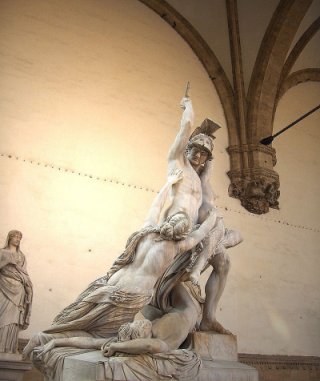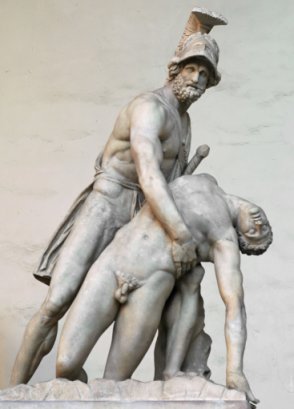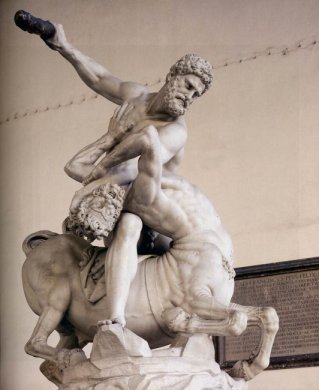On the left is a
relatively modern statue by Pio Fedi (1815 – 1892). A rather confusing
work, particularly in the name it is usually known by, The Rape of
Polyxena. No rape, in the modern sense, was involved in the original
story. Polyxena was the youngest daughter of King Priam of Troy and
Queen Hecuba. Following the fall of Troy, she was taken off by
Neoptolemus to be sacrificed on the tomb of Achilles, to whom she was
betrothed. Some versions say that she was complicit in the death of
Achilles. Polyxena and Neoptolemus are the main figures, but there are
two others. The female figure is Hecuba, protesting at the death of her
daughter. There is some debate on who the other male figure may
represent: Polyxena’s brother Polites, or Hector, leading warrior of the
Trojans. Both had died long before the sacrifice of Polyxena
In the centre of the group is what is claimed to be a piece of 1st
century Roman marble statuary. The title, 'Menelaus Supporting the Body
of Patroclus' comes from an event in the Trojan war featuring these two
characters. Patroclus died in battle, and his body was protected from
the vindictive Trojans by Menelaus, as described in the Illiad:
On the cold earth divine
Patroclus spread,
Lies pierced with wounds
among the vulgar dead.
Great Menelaus, touch'd with
generous woe,
Springs to the front, and
guards him from the foe.
(Translation by Alexander Pope.)
But how much is Roman, and how much the product of much later Italian
‘restoration’, or to be more accurate, the creation of a new sculpture
using a Roman original as the base? The head of Menelaus, for example,
was attached to the original headless sculpture.
The third
sculpture shows Heracles (or Hercules if you prefer) slaying the Centaur
Nessus. It was sculpted by the Flemish sculptor Giambologna, who
completed it in 1599 from a single block of marble.
Heracles and his wife Deianira were being separately conveyed
across the River Evenus by Nessus the centaur. Nessus took a fancy to
Deianira and started to misbehave. Heracles was much put out, and he
shot the centaur through the heart with an arrow. The dying Nessus
fooled Deianira into believing that his blood was a love potion she
could use on Heracles. It wasn’t, it was poisonous, resulting in the
death of Heracles.
As you may expect, there is an issue with this. Here Heracles is
sitting on the centaur, beating him with a club, not shooting him at a
distance with a bow and arrow as the legend tells us. Heracles had other
run-ins with centaurs, so this identification may not be correct.
.
.

Pio Fedi: Rape of Polyxena

Menelaus supporting the body of Patroclus

Heracles and the Centaur